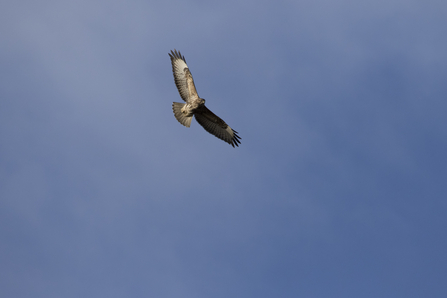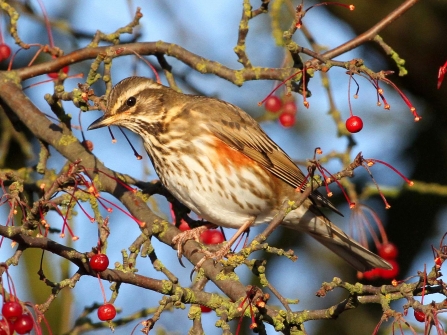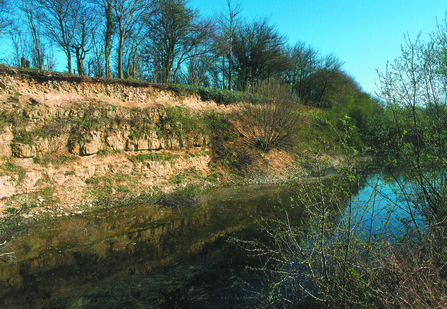
College Lake by Howard Stanbury
10. Winter walk by Martin Wheeler

College Lake by Howard Stanbury
College Lake, Bucks
Nature reclaimed this worked-out chalk quarry and created an outstanding centre for wildlife. The lake, surrounded by reedbeds and wetlands, is a haven for a variety of birds. In the winter, the inhabitants of the water change, and wintering wildfowl, such as wigeon and teal, from Scandinavia and beyond, use the wetlands for feeding and roosting.
College Lake in mid-winter is a perfect spot to witness wildlife in a serene and reflective mood, either birdwatching or on a gentle walk. Try our circular Wildlife Walk (2 miles) by simply following the lapwing waymarkers, and if you want to get out of the cold, head indoors to the visitor centre for a warming cuppa and slice of cake.
Access: Gentle slopes, 90% surfaced paths, gates, benches. Some wheelchair access, including hides.
Please note: some of our paths are uneven.
Two mobility Tramper vehicles are available to use - contact us on 01442 826774 or collegelake@bbowt.org.uk to book.
Wildmoor Heath by Kate Dent
Wildmoor Heath, Berks
Wildmoor Heath is a precious survival of rare heathland habitat, a landscape which has largely disappeared from surrounding countryside. The heath is a sanctuary for species that thrive in its unique conditions, with the soft, spongy mosses and heathland grasses providing essential shelter and nourishment. The open heath with its scattered cover of scrub provides ideal conditions for the Dartford warbler, stonechat and occasionally woodlark.
Follow the badger waymarkers to take our 1.5 miles circular Wildlife Walk around the reserve. A separate part of the reserve called Broadmoor Bottom can be accessed from Magdalene Road off the A3095. This area contains heathland, mire and woodland and is crossed by a number of paths.
Access: Variable, mainly firm, gently sloping, sandy paths, some boggy peat, some rough underfoot, can be very muddy in winter; gates, stiles, boardwalks.

Buzzard in flight by Chris Lawrence
Chinnor Hill, Oxon
Chinnor Hill crown the Chilterns escarpment. The panoramic views are breathtaking, and with any luck you’ll catch red kites and buzzards soaring on the updrift. Chinnor Hill falls steeply to the Icknield Way, part of the ancient Ridgeway. Made up of prehistoric pathways that follow the chalk 'spine' of England, the Ridgeway is thought to be Britain's oldest road.
Follow the badger waymarkers for our circular Wildlife Walk (1 mile) around the reserve, and if you’re looking for some team bonding to start 2025 off on a good foot, keep an eye out for regular volunteer work parties to maintain the reserve.
Access: sloping; steep and stony in places, muddy in places; kissing gates, gates; rest benches.
Wheelchair and mobility vehicle users can gain access to top of reserve with a RADAR key.

Photo taken by Sam Robertson at Foxcote Reservoir
Foxcote Reservoir, Bucks
Enjoy watching the comings and goings of migrating waterfowl in this quiet corner of Buckinghamshire. Bring your binoculars and stay a while in one of our hides, Foxcote Reservoir is the kind of place that rewards patient visitors. Created in 1956 by damming a small tributary of the River Great Ouse, this site has become important for a number of wintering waterfowl.
On a cold winter's day, the expanse of open water is likely to hold rafts of wigeon, coot and tufted ducks (it is the male tufted duck that has the bold black and white plumage). These are often joined by smaller numbers of goldeneye, goosander, teal, shoveler and occasionally pintail, striking visitors from further afield.
Access: gentle slope. Wheelchair access possible in dry weather.

Redwing by Margaret Holland
Padworth Common, Berks
Padworth Common is a tranquil haven for wildlife. The swathes of open heathland are set among a tapestry of ancient oaks, grasslands, ponds and pine trees. Nature’s resilience is on full display in this peaceful winter landscape. The damp, cool ecosystem allows hardy moss and lichens to thrive, and the fieldfares and redwings flit between the trees overhead, the bare branches of ancient trees silhouetted against the pale sky.
North common tends to remain relatively dry at this time of year, so it is a good option for anyone looking to really stretch their legs. With numerous paths to choose from, this reserve allows you to enjoy a quiet walk for a few hours.
Access: paths on north common remain relatively dry throughout the year whereas those on south common are seasonally wet but more level. Terrain is largely flat.

Ardley Wood Quarry by Jim Asher
Ardley Wood Quarry, Oxon
This quarry and nearby railway cutting have geological features of national importance - as well as abundant wildlife. The layered bare limestone rock faces give a fascinating insight into the site's Jurassic past (more than 160 million years ago). Medieval earthworks give Ardley Wood Quarry archaeological interest too.
Scrub, woodland and rough grassland make up the diverse array of habitats along with seasonal ponds. Listen out for an array of birds flitting around in the trees. There are also plenty of fungi and mosses to discover.
Access: undulating, mostly firm and flat; steep embankment to south.